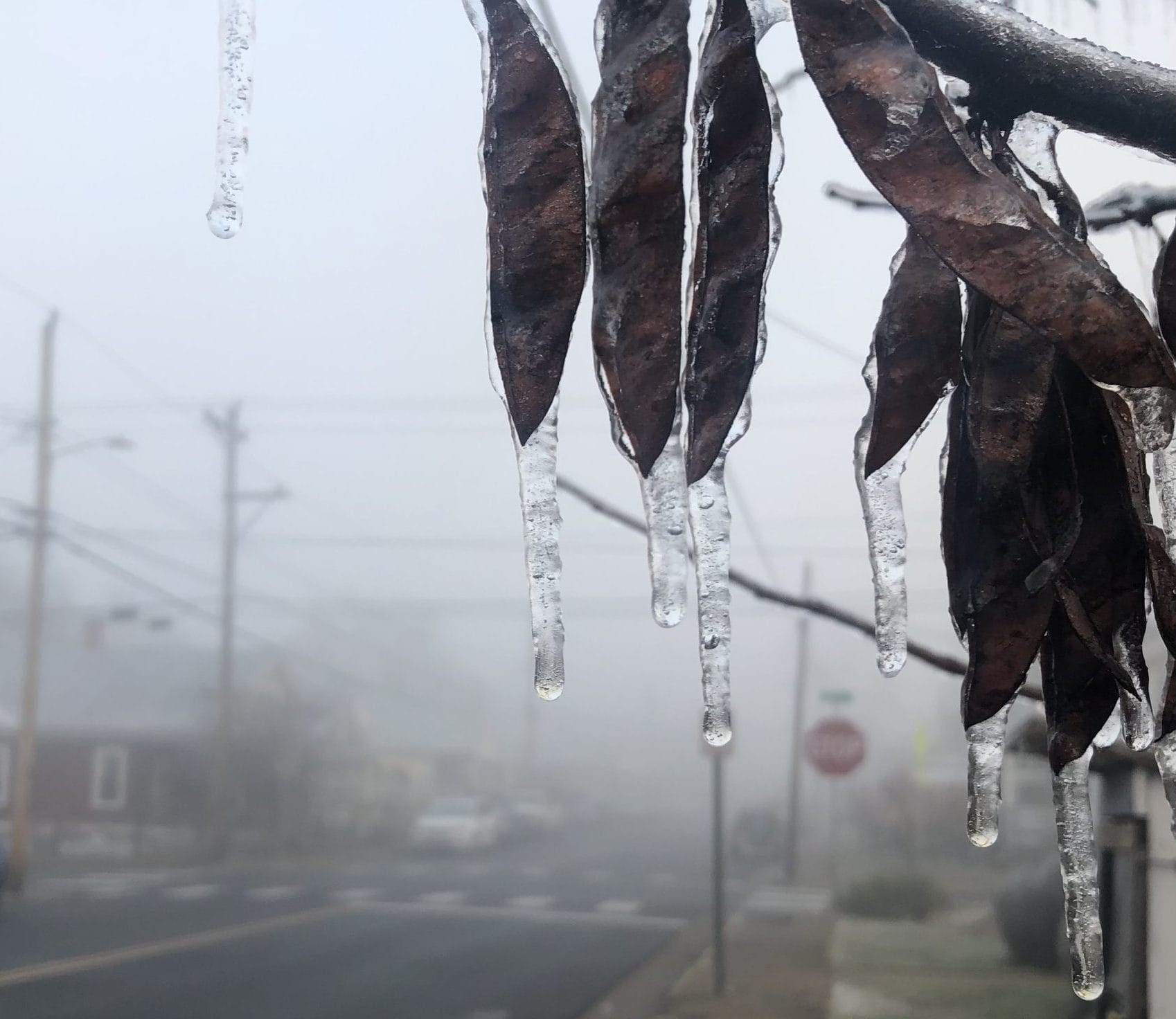
By Sofia Samatar
“The Friendly City” is a weekly column about walking in Harrisonburg that will run during 2024. Each week, your friendly correspondent, writer and teacher Sofia Samatar, will reflect on a walk in our city.
On a morning of fog, the trees gray with frost after the ice storm, I’m wondering: What is a city?
Only the houses directly in front of me stand out clearly. The trees behind them are thin ghosts, seeping into the vapor of the sky. A string of lights, left behind by the holiday season, picks out the shape of a porch railing down the street, twinkling in the dense mist.
With so little visibility, you could imagine yourself in the country, especially when passing a wonderful old peeling house, its windows blind, its walls darkened by somber bushes, that seems to stand all alone in the street, isolated by the fog.
As I walk downhill, the mist lifts. A clicking fills the air: icicles dropping from telephone wires. Since the sidewalk is icy, I stroll in the street, and this is part of what makes the Friendly City feel like a small town to me, not like a city at all. How easy it is to step out into the street, carefully of course, staying close to the parked cars, but without the feeling that I’m taking my life in my hands, confident that any passing vehicle will move at a decorous speed, giving me time to retreat, and anyway, there won’t be too many of them.
I think of the New York Times opinion piece a friend sent me recently, “Baudelaire Would Be Run Over in New York City Today,” in which Shaan Sachdev laments a lost New York where he used to wander in a reverie like the iconic flâneur, the city walker described by the poet Charles Baudelaire. For a flâneur, urban walks are adventures, dreams, and invitations to philosophy. Walking is a particularly open and pleasurable form of thinking. Sachdev worries about what will happen to ideas when walking becomes too hazardous to allow for contemplation. Last summer, he was hit by three bikes.
As the sun melts the ice, each tree releases a private rain. I’m still walking in the street, not because the sidewalk is slick but because there’s no sidewalk—a common occurrence in the Friendly City, for our sidewalk is an unpredictable beast with a lively sense of humor. It flashes up, smooth and amiable underfoot, then dives out of sight, leaving the unsuspecting walker stranded on a neighbor’s grass. There it is again, coaxing you uphill with the promise of a serene stroll; then it dumps you unceremoniously in the street. A friend once told me that early in the city’s history, homeowners were given the choice whether to permit a sidewalk in front of their houses or not, a form of city planning that strikes me as frankly deranged, but would explain why our sidewalk sometimes pops up, wagging its tail, for the length of a single property. In the Friendly City, you must always be prepared to arrive at that magical, tricky place immortalized in Shel Silverstein’s children’s book: Where the Sidewalk Ends. This scruffy, half-grown, misbehaving sidewalk gives our city a small-town air, the feeling of a place that has not yet fully arrived.
Cross the railroad track. Cut through the little garden of Liberty Park, its trees dripping crystal. Behind the park, a wooden bridge spans the creek. Today the planks are treacherous with half-thawed slush, and I slide along cautiously, peering down into the shallow, slate-gray water. When you walk in the Friendly City, you often pass these twin conduits, the railroad track and the creek, and I think this intensifies the small-town atmosphere, the feeling that this is a minor place, where the train doesn’t stop, where everything passes through—the water, the trains, and when you reach downtown, the huge trucks that fill the streets with their thunder, dwarfing the shops and restaurants, as if this place were only part of a highway.
On the courthouse lawn, a plaque informs me that the town was founded in 1779 and became a city in 1916. I’m sure this has to do with population density, and that technically, this place qualifies as a city. But in the collective imagination, a city is more than an official population threshold. It’s energy, danger, opportunity, and above all crowds, those crowds in which, according to Baudelaire, the flâneur should swim like a fish in water, and you won’t find crowds like that in the Friendly City, especially not on a Sunday after an ice storm, unless it’s the flock of ducks sunning themselves on the bank where the creek flows under Wolfe Street. Honestly, I don’t think Baudelaire could stand this town. If you asked him, “Charles, would you rather live without crowds or get hit by a bike,” I think he’d say “Donnez-moi le vélo.”* But if Sachdev is right, and the act of wandering is intimately tied to the act of wondering, then it’s worth noting that it’s still possible to wander here, ambling along the streets, stepping off the curb where the sidewalk ends, falling into daydreams, your gaze sliding down the gentle curve of Main Street, catching for a moment on the red of the pawn shop sign, then slipping free, drawn out like the train, like the waters of the creek, your thoughts bubbling through the air with the rhythm of your strides.
What is this feeling of secrecy, this delight? Even in vivid winter sunlight, the Friendly City seems a little bit veiled, as if still enclosed in a fog: the protective cloak of its power to go unnoticed, to be just another place along the road.
* “Give me the bike.”












